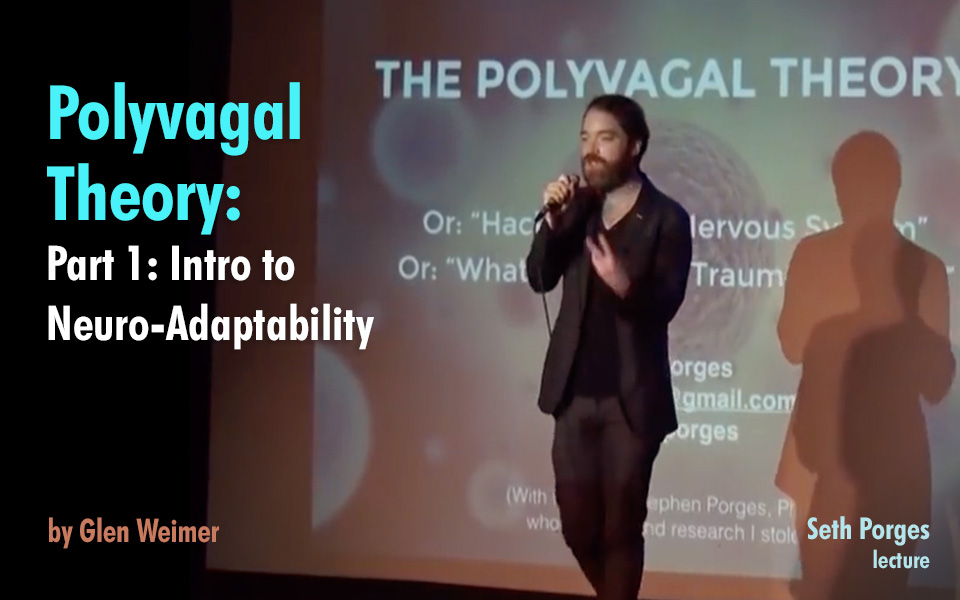Polyvagal Theory – Intro to Neuro-Adaptabilty
Polyvagal theory (gr. ‘polus‘, “‘many’” + ‘vagal‘, “‘vagus nerve'”)
posits that the Vagus or 10th Cranial Nerve influences
three distinct branches of the Autonomic Nervous System.
Polyvagal Theory may sound like a scary sciency-thing but, in fact, it is a topic that is easy to understand, and profoundly impacts each of our lives and the health of bodies. If our body’s came with an owners manual, this would be required reading. It provides the missing link that scientifically establishes the mind-body connection with far reaching implications for health and disease.
Initially proposed in 1994 by Stephen Porgess, PhD, Polyvagal Theory has broadened our understanding of the Autonomic Nervous System (ANS) and its relationship to the impact of stress and trauma/overwhelm on our BodyMind System (BMS). Dr. Porgess proposed a concept he called Neuroception, the nervous system’s continuous process of scanning our environment to determine safety, as well as our systemwide response to various levels of threat which initiate a cascade of physiological and psychological changes to our BMS.
This is a topic I’ve glossed over in other blogs on Overwhelm and Resourcing because, although easy to understand, it not only requires but truly deserves a more detailed explanation. This 5-part blog on Polyvagal Theory is a combination of Dr. Porges’ work, and my own insights from 25+ years of utilizing it in my consciousness-based therapy practice.
Continue reading to get a fuller understanding. Go to Polyvagal Theory – Part 2
Video
In this short video, Seth Porges (son of Dr. Stephen Porges) is hysterically funny and extremely articulate in presenting the fundamentals of Polyvagal Theory. I often send this clip to clients as a useful overview. It sets the stage for some deeper explorations in parts 2 to 5 of this blog.
Video Index
- Intro – 0:00
- What is the ANS? – 0:34
- PNS & SNS – 0:58
- ANS Evolution & Function – 1:36
- Neuroception – 2:16
- Old Model: 2 Modes / Binary – 3:30
- New Model: 3 Tier / Hierarchical – 3:40
- Safety / Ventral Vagal Parasympathetic – 5:14
- Danger / Sympathetic – 6:06
- Life Threat / Dorsal Vagal Parasympathetic – 6:50
- Neuroception Regulation – 7:34
- ANS Evolutionary Hierarchy – 9:32
- Understanding Trauma – 10:38
- Navigating 3 ANS States: Healthy vs Unhealthy – 10:44
- ANS As Comprehensive System – 13:12
- Vagus Nerve – 13:43
- Vagus As Neural Brake – 14:10
- Breathing Regulates ANS – 14:50
- Vagus’ Evil Twin / Dorsal Vagus – 16:20
- Vagus: Two Branches – 17:16
- Anxiety / Danger – 18:08
- Why Trauma Lasts – 18:58
- List of Psych Responses – 19:38
- Safety State – 20:30
- IBS – 21:34
- Proximity & Bonding – 21:56
- Biological Imperative – 22:18
- Bonding – 22:50
- Relationships – 23:50
- Let’s Fix It – 24:02
- ANS Is Self-Reinforcing – 25:16
- Neuroception: Danger – 25:54
- Neuro-Hacks – 26:24
- 9 Take Aways – 27:10
Stephen W. Porges, PhD
Stephen W. Porges, PhD, is distinguished University Scientist at Indiana University, where he directs the Trauma Research Center within the Kinsey Institute. He holds the position of Professor of Psychiatry at the University of North Carolina and Professor Emeritus at the University of Illinois at Chicago and the University of Maryland. He served as president of both the Society for Psychophysiological Research and the Federation of Associations in Behavioral & Brain Sciences and is a former recipient of a National Institute of Mental Health Research Scientist Development Award. He has published more than 250 peer-reviewed scientific papers across several disciplines.
In 1994 he proposed the Polyvagal Theory, a theory that links the evolution of the mammalian autonomic nervous system to social behavior and emphasizes the importance of physiological state in the expression of behavioral problems and psychiatric disorders. The theory is leading to innovative treatments based on insights into the mechanisms mediating symptoms observed in several behavioral, psychiatric, and physical disorders. In 2018, Dr. Porges received the Pioneer Award from the United States Association for Body Psychotherapy.
Seth Porges
Seth Porges is an American science and technology journalist and television commentator. He appears on numerous television shows on the History, National Geographic, Discovery, American Heroes and Travel channels. Previously, he worked as a senior editor at Maxim magazine, as an editor at Popular Mechanics magazine, as the technology columnist at Bloomberg News and as a writer for TechCrunch. He is a graduate of Northwestern University’s Medill School of Journalism. Seth is the son of the neuroscientists, Drs. Stephen Porges and C. Sue Carter.
Polyvagal Theory Resources:
- Dana, Deb A., Anchored: How to Befriend Your Nervous System Using Polyvagal Theory (2022)
- Dana, Deb A., The Polyvagal Theory in Therapy: Engaging the Rhythm of Regulation (2018)
- Porges, Stephen W., The Pocket Guide to the Polyvagal Theory: The Transformative Power of Feeling Safe (2017)
- Rosenberg, Stanley, Accessing the Healing Power of the Vagus Nerve: Self-help Exercises for Anxiety, Depression, Trauma and Autism (2017)
- Also go to blogs Resourcing: Meeting Life’s Challenges
- Overwhelm: The Root Cause of All Disease – Parts 1 to 4
Disclaimer:
The information featured on this site is provided for information and education purposes only and is not intended to replace the advice of your doctor or health care provider on medical and/or health-related issues.
You should not use the information on this site for diagnosis or treatment of any health problem or as a substitute for medication or other treatment prescribed by your physician or health care provider.
Submit your review | |

